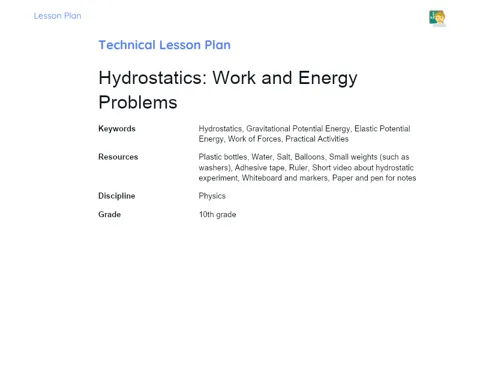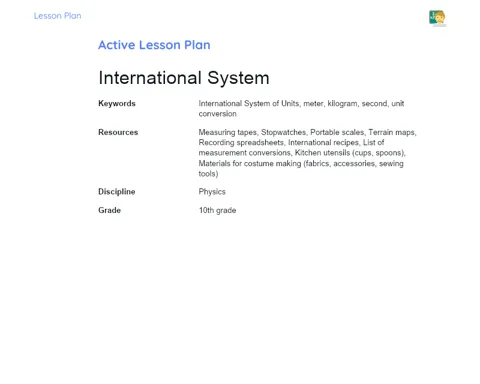Lesson Plan | Traditional Methodology | Waves: Vibration in Strings
| Keywords | Vibration in Strings, Standing Waves, Harmonics, Wavelength, Frequency, Musical Instruments, Constructive Interference, Destructive Interference, Modes of Vibration, Experiments, Digital Simulator |
| Required Materials | Chalkboard and Chalk or Whiteboard and Markers, Projector or Screen for Slide Presentation, Slides with Lesson Content, Notebook and Pen for Student Notes, Vibrating String or Digital Wave Simulator, Computer with Internet Access (for using the Simulator), Scientific Calculator |
Objectives
Duration: (10 - 15 minutes)
This stage of the lesson plan aims to introduce the main objectives that students should achieve by the end of the lesson. Clearly defining the objectives helps guide both the teacher and the students during the explanation, ensuring that everyone is aligned regarding what is expected to be learned and understood about the vibration in strings and its associated concepts.
Main Objectives
1. Describe the phenomenon of vibration in strings, focusing on the stationary regime.
2. Relate the wavelength to the respective harmonic.
3. Connect the length of the string with the different harmonics generated.
Introduction
Duration: (10 - 15 minutes)
This stage aims to introduce students to the concept of vibration in strings in an engaging and contextualized manner. By presenting the topic in an accessible and connected way, students can better understand the relevance of the content that will be covered throughout the lesson. Furthermore, the introduction serves as a solid foundation for building more in-depth knowledge, ensuring that all students are on the same page before moving on to more detailed explanations.
Context
To begin the lesson on vibration in strings, it is essential to contextualize the topic within the students' daily lives. Start by explaining that vibration in strings is a physical phenomenon that can be observed in various musical instruments like guitars, violins, and pianos. These instruments produce pleasant sounds due to the standing waves that form in their strings. Understanding this phenomenon not only enriches knowledge about physics but also allows for a deeper appreciation of music and the engineering behind these instruments.
Curiosities
🎸 An interesting curiosity is that the strings of a guitar, for example, can vibrate in different ways to produce distinct notes. The length of the string, its tension, and thickness directly influence the frequencies of the standing waves formed, and consequently, the sounds we hear. This is a principle that is also used in other areas, such as bridge construction and molecular modeling in chemistry.
Development
Duration: (45 - 55 minutes)
The purpose of this stage is to provide an in-depth and detailed understanding of the phenomenon of vibration in strings, focusing on the concepts of standing waves, harmonics, wavelength, and their practical applications. By addressing these topics clearly and providing detailed examples, students will have a solid foundation to understand the physics behind musical instruments and other vibrating systems. The proposed questions serve to reinforce the acquired knowledge and ensure that students can apply the discussed concepts to practical problems.
Covered Topics
1. 1. Standing Waves in Strings: Explain the concept of standing waves, emphasizing that they are patterns of vibration that form in strings fixed at both ends. Detail that these patterns occur due to constructive and destructive interference of the waves reflecting at the ends of the string. 2. 2. Harmonics: Discuss the modes of vibration that the string can assume, known as harmonics. Explain that the first harmonic (fundamental) has a node at each end and an antinode in the middle, while the higher harmonics have additional nodes and antinodes between the ends. 3. 3. Wavelength and Frequency: Relate the wavelength to the length of the string, highlighting that for the n-th harmonic, the wavelength is equal to twice the length of the string divided by the harmonic number. Discuss how frequency is related to wavelength and wave speed in the string. 4. 4. Applications in Musical Instruments: Connect theory to practice by explaining how the principles of vibration in strings are applied in the design and operation of musical instruments such as guitars, violins, and pianos. Highlight the importance of tension, length, and thickness of the string in producing different musical notes. 5. 5. Experiments and Demonstrations: If possible, use a vibrating string or a digital simulator to demonstrate the different modes of vibration and harmonics. Show visually how nodes and antinodes form in the string, helping students visualize the concept of standing waves.
Classroom Questions
1. 1. Describe how standing waves are formed in a string fixed at both ends. What are the necessary conditions for a standing wave to occur? 2. 2. Explain the difference between the first harmonic and the second harmonic in a vibrating string. How do the wavelength and frequency of each harmonic relate to the length of the string? 3. 3. A guitar has a string length of 0.65 meters. If the wave speed in the string is 520 m/s, calculate the frequency of the first and second harmonics.
Questions Discussion
Duration: (20 - 25 minutes)
This stage aims to review and consolidate the knowledge acquired during the lesson. By discussing the presented questions in detail and engaging students with reflective questions, the teacher ensures that the concepts have been correctly understood and provides an opportunity for students to clarify any doubts. Moreover, active student engagement fosters a collaborative and critical learning environment.
Discussion
-
- Formation of Standing Waves: Standing waves in a string fixed at both ends form when there is constructive and destructive interference between the waves reflecting at the ends of the string. The necessary conditions for standing waves to occur are: the string must be fixed at both ends, and the wave frequency must be such that it allows the formation of nodes and antinodes along the string.
-
- Difference between Harmonics: The first harmonic, or fundamental, has a node at each end and an antinode in the middle of the string. The second harmonic has a node at each end and an additional node in the middle of the string, creating two antinodes. The wavelength of the first harmonic is twice the length of the string, while that of the second harmonic is equal to the length of the string divided by two. The frequency of the second harmonic is double that of the first harmonic.
-
- Calculation of Harmonic Frequencies: For the guitar with a string length of 0.65 meters and a wave speed of 520 m/s, the frequency of the first harmonic (f1) is given by f1 = v / (2*L), where v is the wave speed and L is the string length. Therefore, f1 = 520 / (2 * 0.65) = 400 Hz. The frequency of the second harmonic (f2) is double the frequency of the first harmonic, i.e., f2 = 2 * 400 = 800 Hz.
Student Engagement
1. 1. How does the tension of the string affect the frequency of the harmonics? Discuss the practical implications of this in musical instruments. 2. 2. If a guitar string is shortened by half, how will this affect the harmonics produced? Explain. 3. 3. Ask students how they think the properties of the string material (e.g., density, elasticity) influence standing waves. 4. 4. Propose a thought experiment: If a string were made of a non-elastic material, how would this affect the formation of standing waves? 5. 5. Encourage students to reflect on the relationship between the physics of standing waves and other areas such as civil engineering (e.g., in bridges and buildings).
Conclusion
Duration: (10 - 15 minutes)
The purpose of this stage is to review and consolidate the main points covered during the lesson, ensuring that students have a clear and cohesive understanding of the content. Additionally, it reinforces the connection between theory and practice, highlighting the relevance of the topic to students' everyday lives.
Summary
- Standing waves in strings form due to constructive and destructive interference.
- Harmonics are modes of vibration characterized by different patterns of nodes and antinodes in the strings.
- The wavelength of a harmonic is related to the length of the string and the harmonic number.
- The frequency of the harmonics depends on the length of the string and the wave speed in the string.
- The principles of vibration in strings are applied in the design and functioning of musical instruments.
The lesson connected the theory of vibration in strings with practice by demonstrating how these concepts are utilized in the design and functioning of musical instruments such as guitars and pianos. Practical examples and specific calculations helped illustrate how theory translates into the real sounds we hear from the instruments.
Understanding vibration in strings is crucial not only for physics but also for music and engineering. Curiosities like the production of different musical notes in instruments and the application of these principles in structures like bridges and buildings demonstrate the practical importance and everyday relevance of this knowledge.



